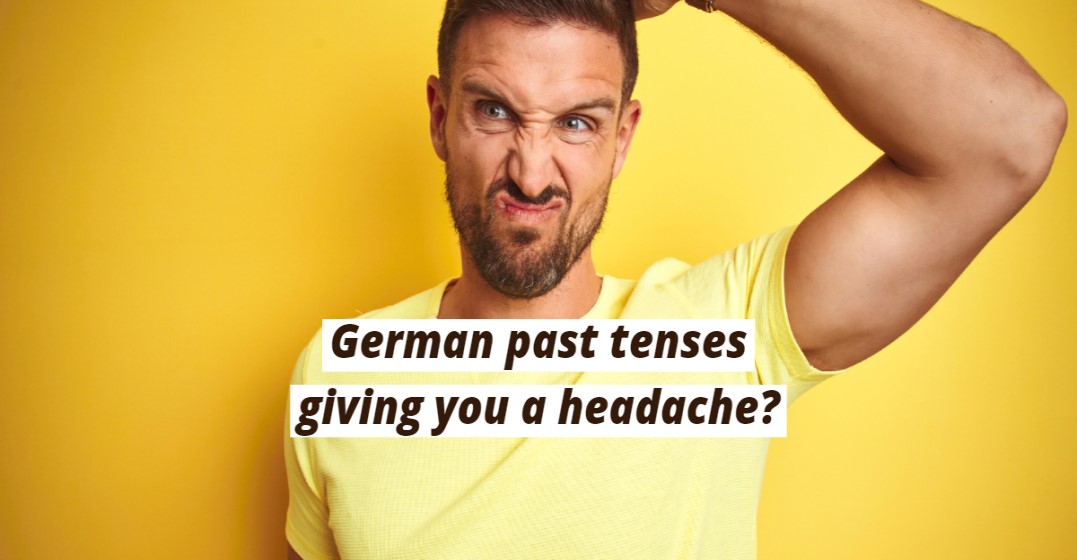Updated on January 8, 2024

How Do Germans Talk About the Past?

In this week’s topic about the amazing German language, we will tackle a topic that might have given you already a rather heavy headache in your learning experience. Every culture has a different perception of time and therefore learning about the past tense may not only be a challenge on the grammatical level but also on the cultural one.
I always get confused with the tenses in English, so I really feel you out there! And that’s why we will have a much closer look at the German idea of the past.
Germans generally have three past tenses to converse with. Two of them are describing the same time.
A completed action that lays in the past. These are the “Perfekt“ and the „Präteritum“.
The third tense describes the past that happened before the past, called „Plusquamperfekt“. Yeah you heard right, we got you covered to talk about pasts that are so past that the pasts are past 😉
But let’s look at it a little more detailed, to get the knots in our brains sorted:
The Perfekt tense is mostly used in conversational German. It is more regular, and therefore easier to build. Also it is not as formal as the “Präteritum”. Even though we use it mostly in spoken German, it can also appear in written German. Unlike English, German does not distinguish between an action in the past that ended or that is not yet finished. This is important to understand the past tenses in German.
For example:
I have lived in Germany for 3 years. For English speakers this sentence describes an action still in progress. I am still living in Germany.
It is not possible to say this in a past sentence in German. If we say: Ich habe 3 Jahre in Deutschland gewohnt. – it describes that I do not live in Germany anymore. The action is over and completed. This may also be the reason why you find Germans struggling with the concept of progressive tenses in English.
If we want to express an ongoing progressing action in German, we have to use the present tense:
Ich wohne seit 3 Jahren in Deutschland – I live in Germany since 3 years.

This tense is a compound tense and consists of an auxiliary or helping verb which is either haben (to have) or sein (to be).
The helping verb will be regularly conjugated in the present tense and is placed into the second position in a main sentence.
The other component is the Partizip 2 (past participle) of the main verb, that tells us about the past action.
The past participle of regular verbs is mainly built with ge- prefix and a -t or -et suffix to the stem verb. It is always placed at the end of the main sentence and sort of “closes up” the sentence.
German consists of a lot of irregularities when it comes to verbs and past conjugation. We have regular and irregular verbs.
Please keep in mind, sein is always used with verbs of action or change of circumstance.
Now let’s look at all this brain-trouble in some examples:
Ich habe Suppe gekocht. – I cooked soup.
Peter hat den Fernseher eingeschaltet. – Peter switched on the TV.
If you have a separable prefix verb that you want to transform into a Partizip 2, place the “ge” between prefix and verb stem.
Susanne ist Fahrrad gefahren. – Susanne drove her cycle/cycled.
The Partizip 2 here is different, because fahren, as many other verbs describing motion is irregular.

I guess in English this tense would be called simple because it is simple, compared to the perfect tense! It only consists of one word, the verb in its past conjugation.
Although in the first attempt it seems simple, the Präteritum has a lot of irregular verbs, which is why it is not used too much in conversational German.
The Präteritum was the main tense used in the olden days. It sounds much more formal and gives our speech a touch of elegance. Nowadays, the Präteritum is mostly used in formal situations or to narrate stories, often in written contexts like novels, newspapers or recipes.
It describes the same time frame as the “Perfekt”.
As said earlier, the Präteritum consists mostly of only one verb. To conjugate regular verbs in the Präteritum, you take the verb stem and add the Präteritum specific ending, which you can see in the table below.
| regular verbs | |
| ich | -te |
| du | -test |
| er, sie, es | -te |
| wir | -ten |
| ihr | -tet |
| Sie, sie | -ten |
For example:
Sie kauften das Auto. – They bought the car
main verb: kaufen
Sie kochte eine Suppe. – She cooked soup.
main verb: kochen
Er ging in die Schule. – He went to school.
main verb: gehen
Besides using the Präteritum mostly in a formal way, there are actually three verbs that are frequently used in conversational German.
They are:
sein – to be
Ich war gestern zu Hause. – I was at home yesterday.
haben – to have
Er hatte am Montag keine Schule. – He had no school on Monday.
werden – to become
Er wurde Arzt. – He became a doctor.
| sein | haben | werden | |
| ich | war | hatte | wurde |
| du | warst | hattest | wurdest |
| er, sie, es | war | hatte | wurde |
| wir | waren | hatten | wurden |
| ihr | wart | hattet | wurdet |
| Sie, sie | waren | hatten | wurden |
These main verbs are frequently used in Präteritum instead of the “Perfekt” tense.
The Plusquamperfekt is a tense, used mainly in written contexts and describes an action that happened in the past before another action happened. It describes the past earlier to the younger past.
All we have to do is to use the “Perfekt” and use the past tense of the auxiliary or helping verb. Please note, the Plusquamperfekt can never stay alone and is always accompanied with the action that happened after it. It therefore always appears in a time-frame context.
For example:
Er war bereits nach Hause gegangen, als der Chef ihn anrief. – He had already gone home when the boss called him.
Wir hatten schon gegessen, als du angekommen bist. – We had eaten, when you arrived.